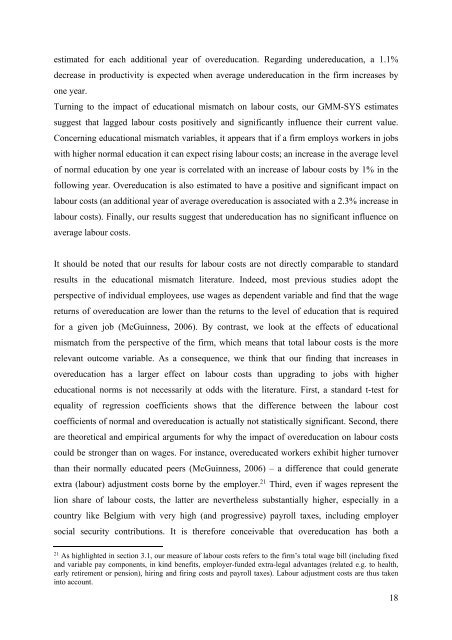CEB Working Paper
240798&r=lma
240798&r=lma
Create successful ePaper yourself
Turn your PDF publications into a flip-book with our unique Google optimized e-Paper software.
estimated for each additional year of overeducation. Regarding undereducation, a 1.1%<br />
decrease in productivity is expected when average undereducation in the firm increases by<br />
one year.<br />
Turning to the impact of educational mismatch on labour costs, our GMM-SYS estimates<br />
suggest that lagged labour costs positively and significantly influence their current value.<br />
Concerning educational mismatch variables, it appears that if a firm employs workers in jobs<br />
with higher normal education it can expect rising labour costs; an increase in the average level<br />
of normal education by one year is correlated with an increase of labour costs by 1% in the<br />
following year. Overeducation is also estimated to have a positive and significant impact on<br />
labour costs (an additional year of average overeducation is associated with a 2.3% increase in<br />
labour costs). Finally, our results suggest that undereducation has no significant influence on<br />
average labour costs.<br />
It should be noted that our results for labour costs are not directly comparable to standard<br />
results in the educational mismatch literature. Indeed, most previous studies adopt the<br />
perspective of individual employees, use wages as dependent variable and find that the wage<br />
returns of overeducation are lower than the returns to the level of education that is required<br />
for a given job (McGuinness, 2006). By contrast, we look at the effects of educational<br />
mismatch from the perspective of the firm, which means that total labour costs is the more<br />
relevant outcome variable. As a consequence, we think that our finding that increases in<br />
overeducation has a larger effect on labour costs than upgrading to jobs with higher<br />
educational norms is not necessarily at odds with the literature. First, a standard t-test for<br />
equality of regression coefficients shows that the difference between the labour cost<br />
coefficients of normal and overeducation is actually not statistically significant. Second, there<br />
are theoretical and empirical arguments for why the impact of overeducation on labour costs<br />
could be stronger than on wages. For instance, overeducated workers exhibit higher turnover<br />
than their normally educated peers (McGuinness, 2006) – a difference that could generate<br />
extra (labour) adjustment costs borne by the employer. 21 Third, even if wages represent the<br />
lion share of labour costs, the latter are nevertheless substantially higher, especially in a<br />
country like Belgium with very high (and progressive) payroll taxes, including employer<br />
social security contributions. It is therefore conceivable that overeducation has both a<br />
21<br />
As highlighted in section 3.1, our measure of labour costs refers to the firm’s total wage bill (including fixed<br />
and variable pay components, in kind benefits, employer-funded extra-legal advantages (related e.g. to health,<br />
early retirement or pension), hiring and firing costs and payroll taxes). Labour adjustment costs are thus taken<br />
into account.<br />
18


